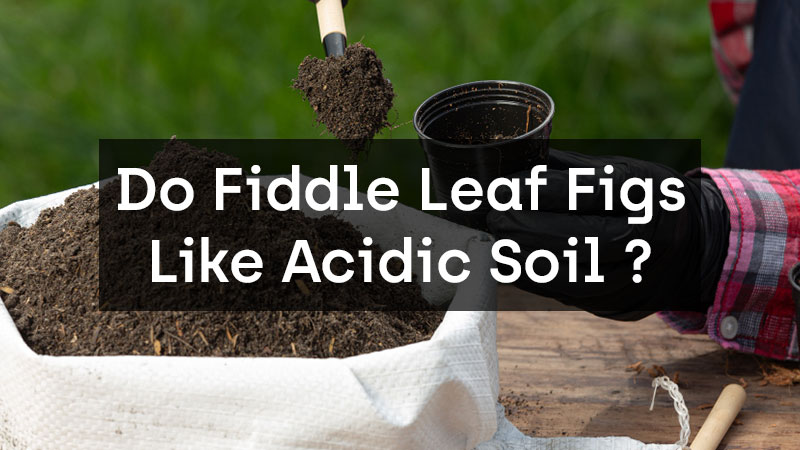Introduction
Fiddle leaf figs (Ficus lyrata) have gained popularity as stunning and elegant houseplants due to their large, glossy leaves and striking appearance. To provide the ideal growing environment for your fiddle leaf fig, understanding its soil preferences is essential.
Understanding Soil pH
Soil pH refers to the acidity or alkalinity level of the soil. It is measured on a scale of 0 to 14, with a pH of 7 considered neutral. pH values below 7 indicate acidic soil, while values above 7 indicate alkaline soil. Fiddle leaf figs generally prefer slightly acidic soil conditions for optimal growth.
Acidic Soil for Fiddle Leaf Figs
Fiddle leaf figs do indeed prefer acidic soil, with a pH ranging from 5.5 to 6.5. This slightly acidic environment mimics the natural conditions of their native habitat and promotes nutrient availability for the plant’s roots. When the soil pH is within the preferred range, fiddle leaf figs can efficiently absorb essential minerals from the soil.
Benefits of Acidic Soil
Acidic soil provides several benefits for fiddle leaf figs. Firstly, it enhances nutrient uptake by making vital minerals, such as iron and manganese, more readily available to the plant. These nutrients play a crucial role in maintaining healthy foliage and preventing deficiencies. Acidic soil also helps prevent certain fungal and bacterial diseases that can harm fiddle leaf figs.
How to Test Soil pH
To determine the pH of your fiddle leaf fig’s soil, you can use a soil pH testing kit, which is readily available at gardening stores or online. Follow the instructions provided with the kit to obtain an accurate reading. Testing the soil periodically allows you to monitor and maintain the optimal pH levels for your plant.
Adjusting Soil pH
If the pH of your fiddle leaf fig’s soil is outside the preferred range, there are ways to adjust it. To lower the pH and make the soil more acidic, you can incorporate organic materials such as peat moss or compost into the soil mix. These amendments help create an acidic environment and improve nutrient availability. On the other hand, if the soil is too acidic, you can add agricultural lime to raise the pH gradually.
Other Factors to Consider
While soil pH is important, it’s not the sole factor that determines the overall health of your fiddle leaf fig. Other elements, such as proper watering, adequate lighting, and suitable temperature conditions, also contribute to its well-being. Therefore, ensure you provide your fiddle leaf fig with the right combination of factors for optimal growth.
Signs of Acidic Soil Imbalance
It’s crucial to keep an eye out for signs of soil pH imbalance in your fiddle leaf fig. Symptoms of acidic soil imbalance may include stunted growth, yellowing leaves, leaf drop, or the appearance of brown spots. Monitoring the plant’s health and regularly checking the soil pH can help you address any issues promptly.
Troubleshooting Acidic Soil Issues
If you suspect an acidic soil imbalance, you can take steps to correct the problem. Adjusting the pH gradually and monitoring the plant’s response is recommended to prevent further stress. Additionally, ensure your fiddle leaf fig receives adequate sunlight, proper watering, and a suitable humidity level to support its recovery.
Alternative Soil Options
While fiddle leaf figs generally prefer slightly acidic soil, they can tolerate a range of pH levels. If you’re unable to maintain the ideal pH, there are alternative soil options available that are specifically formulated for tropical plants. These soils often have balanced pH levels and contain organic matter to promote healthy growth.
Conclusion
In conclusion, fiddle leaf figs do indeed prefer slightly acidic soil conditions for optimal growth. Maintaining a pH range of 5.5 to 6.5 allows these plants to access essential nutrients and thrive in an environment similar to their natural habitat. Regularly monitoring and adjusting soil pH, along with considering other factors such as lighting and watering, will contribute to the overall health and well-being of your fiddle leaf fig.
FAQs
1. Can I use coffee grounds to make soil more acidic for fiddle leaf figs?
While coffee grounds are acidic, they may not be the best option for adjusting soil pH for fiddle leaf figs. Coffee grounds can contribute to an imbalance in soil pH and may lead to other issues. It’s better to use organic materials like peat moss or compost to create a slightly acidic environment.
2. Should I repot my fiddle leaf fig if the soil pH is too high?
If the soil pH of your fiddle leaf fig is too high, repotting may not be necessary. You can gradually lower the pH by adding organic amendments like peat moss or compost to the soil. Monitor the plant’s response, and if necessary, consider repotting in a new soil mix with the desired pH.
3. Can I use vinegar to lower soil pH for my fiddle leaf fig?
Using vinegar to lower soil pH is not recommended for fiddle leaf figs. Vinegar is highly acidic and can potentially harm the plant’s roots. It’s best to use organic amendments like peat moss or compost to achieve the desired soil acidity level.
4. Is it possible to make soil too acidic for fiddle leaf figs?
Yes, it is possible to make the soil too acidic for fiddle leaf figs. Extremely acidic soil can be detrimental to the plant’s health and inhibit nutrient uptake. It’s important to maintain the pH within the preferred range of 5.5 to 6.5 to ensure optimal growth.
5. Are there any other benefits of acidic soil for fiddle leaf figs?
Apart from improved nutrient availability, acidic soil helps create an environment that is less favorable for certain fungal and bacterial diseases that can affect fiddle leaf figs. Maintaining a slightly acidic pH can contribute to the overall health and resilience of the plant.







0 Comments